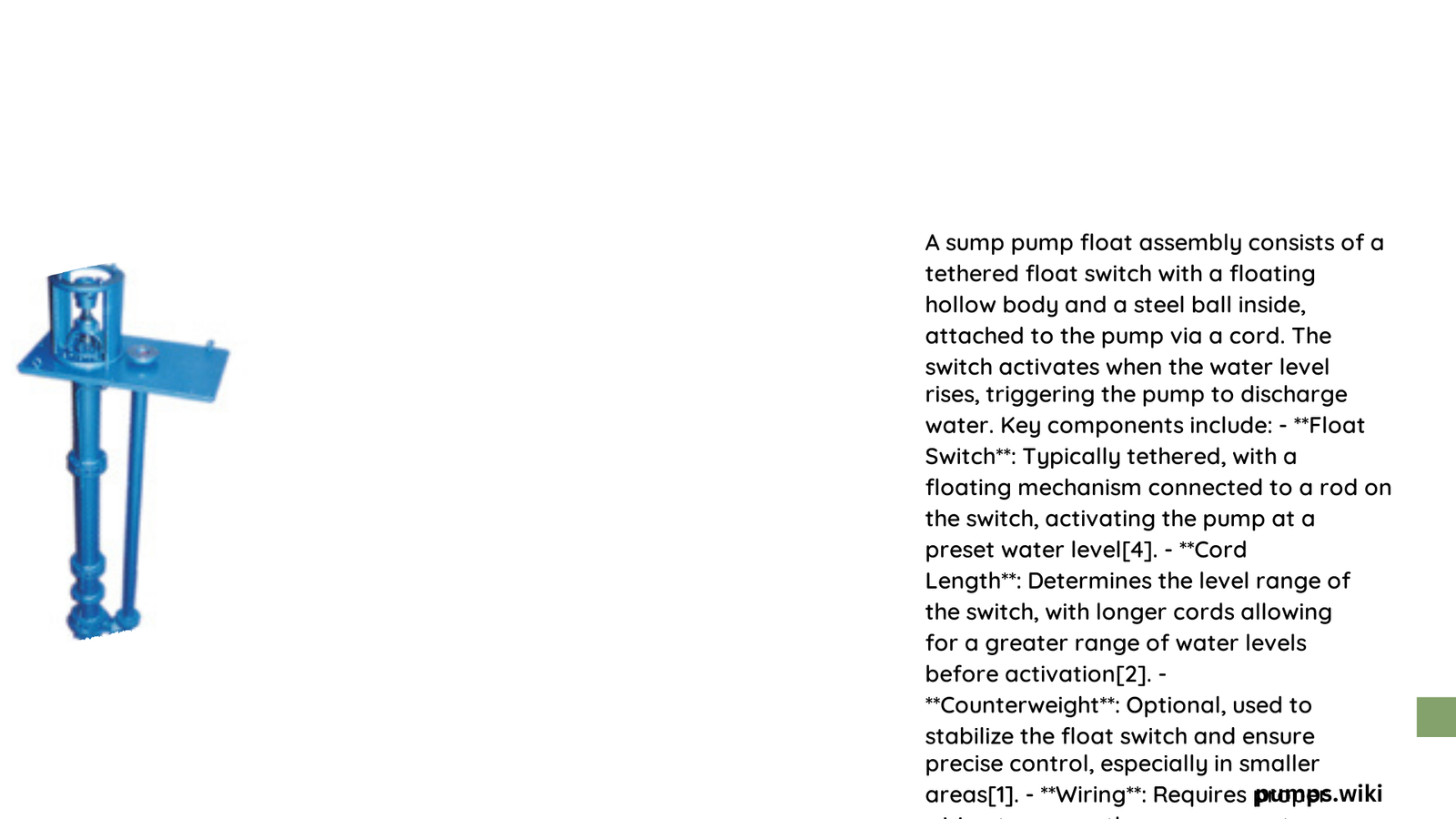A sump pump float assembly is a critical component in basement water management systems, responsible for automatically activating and deactivating the pump based on water levels. This intricate mechanism uses a floating device to detect rising water, triggering the pump to remove excess water and prevent potential flooding, ensuring your basement remains dry and protected from water damage.\n\n## What Comprises a Sump Pump Float Assembly?\n\nA sump pump float assembly typically consists of several key components that work together to monitor and control water levels:\n\n### Primary Components\n\n| Component | Function | Material |\n|———–|———-|———-|\n| Float Switch | Detects water level | ABS/Polypropylene |\n| Tether/Cord | Connects float to switch | Flexible Electrical Cable |\n| Mounting Bracket | Secures float in sump pit | Stainless Steel/Plastic |\n\n### Technical Specifications\n\n#### Float Dimensions and Characteristics\n- Typical size: 4.8 × 2.9 × 4.8 inches\n- Average weight: 1.2 lbs\n- Foam-filled construction for durability\n\n#### Electrical Ratings\n- Voltage range: 120-240 VAC\n- Power capacity: 1/2 HP to 1 HP\n- Maximum current: 13 Amps\n\n## How Does a Sump Pump Float Assembly Work?\n\nThe sump pump float assembly operates through a simple yet effective mechanism:\n\n1. Water Level Detection\n – As water rises in the sump pit, the float begins to rise\n – When water reaches a predetermined level, the float triggers the switch\n – The switch activates the pump to remove excess water\n\n2. Automatic Shut-Off\n – Once water level decreases, the float drops\n – Switch deactivates the pump\n – Prevents continuous pump operation\n\n## What Are Common Float Assembly Problems?\n\n### Potential Issues\n- Float mechanism sticking\n- Incorrect water level calibration\n- Electrical connection failures\n- Mechanical wear and tear\n\n### Diagnostic Techniques\n- Visual inspection of float movement\n- Electrical continuity testing\n- Resistance measurements\n- Tether length verification\n\n## How to Maintain Your Sump Pump Float Assembly?\n\n### Maintenance Checklist\n- Quarterly visual inspections\n- Clean float and surrounding area\n- Check electrical connections\n- Test pump activation mechanism\n- Lubricate moving parts if necessary\n\n### Replacement Considerations\n\n#### When to Replace\n- Inconsistent pump activation\n- Visible physical damage\n- Age over 5-7 years\n- Repeated mechanical failures\n\n#### Estimated Replacement Costs\n- Basic float switch: $20-$50\n- Advanced models: $50-$100\n- Professional installation: $100-$250\n\n## Expert Installation Tips\n\n1. Always disconnect power before servicing\n2. Ensure proper float clearance\n3. Secure mounting brackets\n4. Test through complete water cycle\n5. Verify electrical connections\n\n## Conclusion\n\nUnderstanding your sump pump float assembly is crucial for maintaining a dry, protected basement. Regular maintenance and timely replacements can prevent costly water damage and ensure reliable performance.\n\n### Reference:\n- SMD Fluid Controls Sump Pump Float Switch\n- Tameson Sump Pump Float Switch Principles\n- Pond Guy Float Switch Installation Guide

